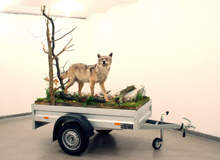
'You can’t learn this theoretically – you have to learn it on your skin,' says eco-artist Newton Harrison. He's discussing more than 30 years of work with partner Helen Mayer Harrison at a presentation they are giving as part of the Barbican Art Gallery's Radical Nature exhibition. The artist is talking about their choice to become full-system farmers but he could just as well be referring to the wider premise behind the exhibition, which spans the past 40 years of art and architecture exploring human interaction with the natural world.
Central to the collection is a strong sense of vision for the future, and there is a refreshing absence of piousness given the subject matter. Rather than settling for condemning the destruction of natural resources, the exhibition's intention is to create and inspire. Each artist has investigated how we might rethink our relationship with the world that surrounds us.
Environmental art
Sculpture, photography, film and installation create a parallel universe in which the outside world appears to have crept into the gallery, spawning a horizontal rainforest (Henrik Håkansson's Fallen Forest), a floating city suspended in mid-air (Tomas Saraceno's Air-Port-City), an infinite mirrored garden (A12's Green Room) and a geodesic dome.
Part of Radical Nature's power lies in the union of well-known pieces of political and environmental art such as Joseph Beuys's Honeypump at the Workplace and Agnes Denes's remarkable Wheatfield – A Confrontation with more recent work from artists including Lara Almarcegui and Luke Fowler. The result is a timeline of the way environmental concerns have shaped art making through the years, encompassing approaches from utopian vision to political protest. Mark Dion's Mobile Wilderness Unit – Wolf, inspired by travelling circuses and their taming of nature, and the Harrisons' practical Full Farm, a movable feast of crops soon to move to a school in London, hint at the way we try, and sometimes need, to make nature fit our expectations of convenience.
Scofidio's The Blur Building fog structure renders barriers between inside and outside almost imperceptible, an idea that continues in Anya Gallaccio's reconstructed indoor tree and Heather and Ivan Morison's outdoor tea house pavilion.

US Tariffs are shifting - will you react or anticipate?
Don’t let policy changes catch you off guard. Stay proactive with real-time data and expert analysis.
By GlobalDataThe captivating short film Richard Buckminster Fuller Modeling Universe by Jaime Snyder plays in a wooden geodesic dome in honour of the celebrated inventor's best-known creation. His statement that 'I am not trying to imitate nature, I am trying to discover and employ the principles she is using' provides an inspiring view of the natural world and his assertion that technology can be beautiful comes to life in a demonstration of the forces at work in a geodesic dome, for which he uses kids' construction toys.
Hans Haacke's mid-60s to early-70s 'real-time systems' of grass growing and water purifying projects, and Wolf Hilbertz's Biorock invention are among pieces that bring the focus of the exhibition from broader visions to the microclimate level, while Simon Starling puts a historical slant on conservation for his floating, Rhododendron-covered Island for Weeds.
Philippe Rahm architects have created Pulmonary Space, a soft construction that inflates as five instruments play a Ligeti composition into apertures in the fabric. A video next to the installation demonstrates the piece in action. Here space 'assumes an architectural form', as Rahm puts it in his writing to accompany the piece.
Tue Greenfort adds ingenious humour with his Daimlerstrasse 38 fox self portraits, captured by the startled-looking animals after the artist hid camera triggers inside frankfurters. After a week the animals had learned to steal the prize without photographing themselves.
The exhibition continues off-site with Indoor Garden Design's reconstruction of Dene's Manhattan wheatfield and The Dalston Mill, a specially commissioned installation from architectural experimenters EXYZT. A disused area of Hackney has been transformed from an impotent space into a working mill capable of feeding the community.
Barbican events programme
The RSA Arts and Ecology Centre has collaborated with the Barbican Art Gallery to host a prolific events programme including talks about the exhibits and the subjects they raise, creative activities for families, guided tours of nearby nature hotspots, cookery demonstrations using locally sourced ingredients and even a barn dance. The partnership between the organisations is a result of curator Francesco Manacorda's previous work with the RSA Arts and Ecology Centre and forms part of Respond!, a nationwide arts campaign publicising environmental issues.
The exhibition puts its money where its mouth is by using old Barbican posters for wall texts and printing gallery guides and catalogues on recycled paper, but it also makes an impact on a less tangible level. As many attempts at environmental campaigning are in danger of losing their meaning by being repeated too often or in predictable contexts, this exhibition offers timely inspiration.
Radical Nature reminds us of the novelty and uniqueness of ideas produced in the post-war period, before green issues became everyday.
The Respond! campaign seeks to sustain this active, challenging relationship between artists, their community and the environment. At a time when Britain's trust in political figures is at a low point, we can look to art for a more honest message of hope for the natural world. On this matter we will return to Newton Harrison: 'When nothing else works, what the hell – give it to the artists.'



